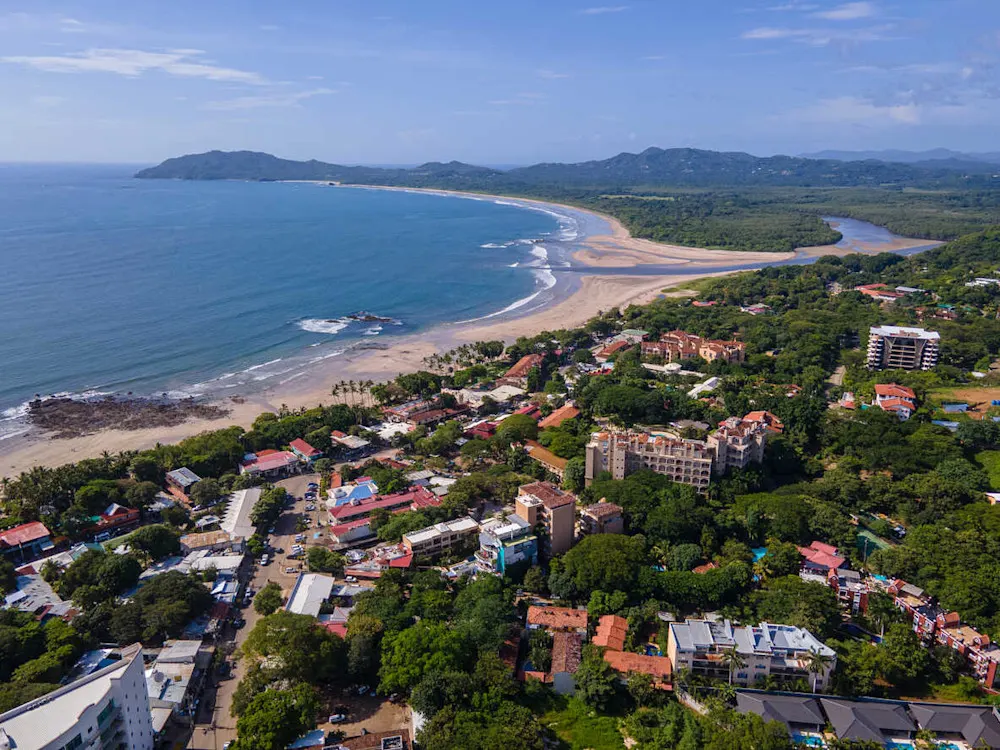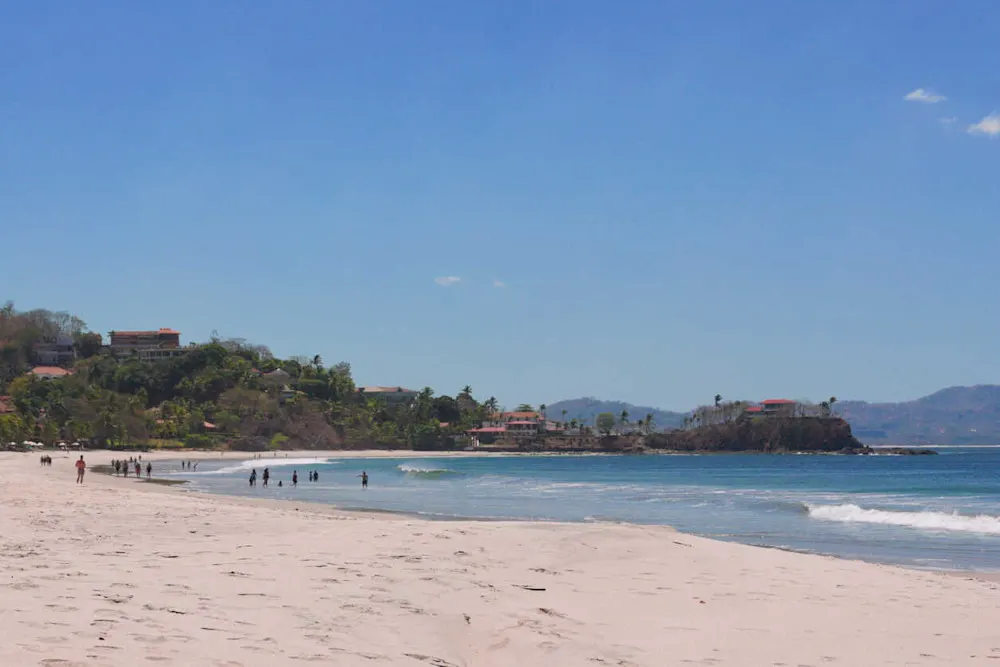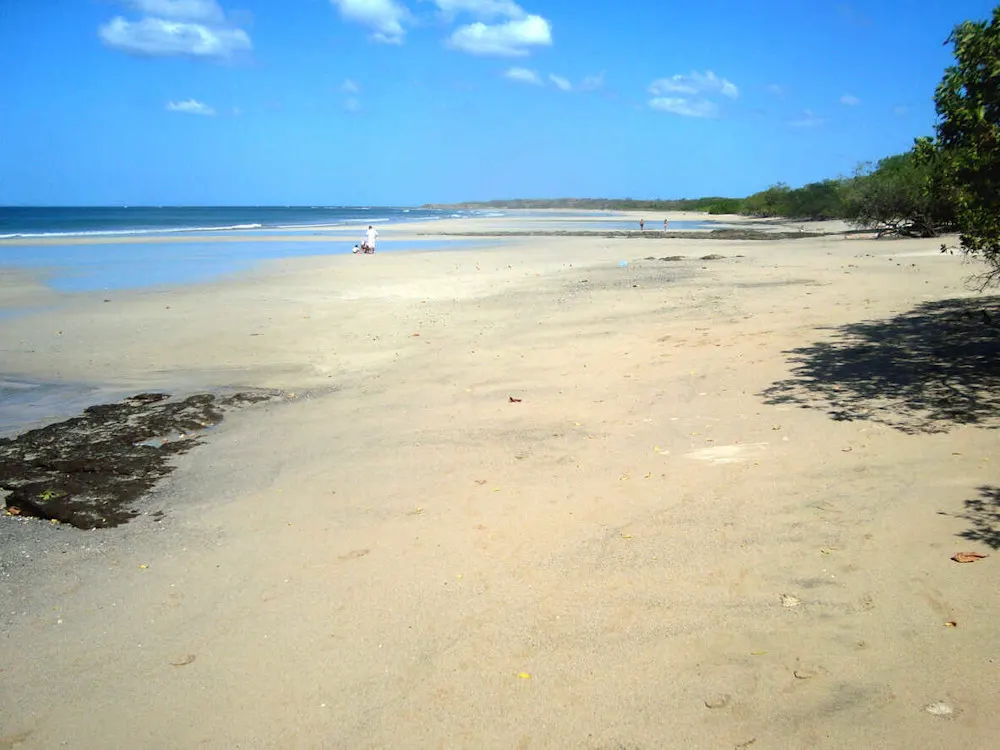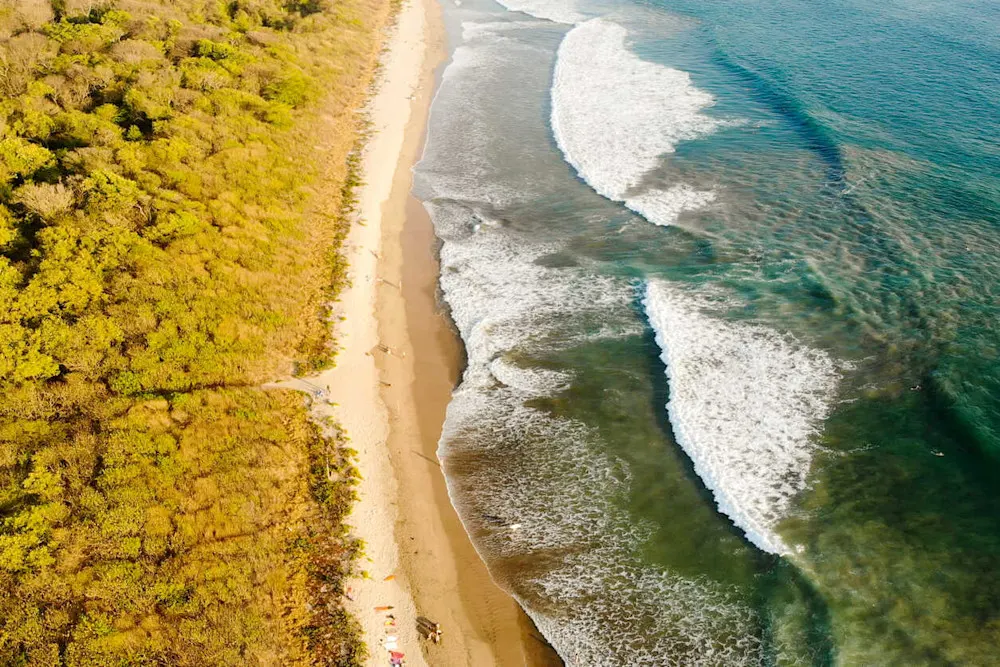The area around Tamarindo in Guanacaste, Costa Rica, has become a top destination for families looking to trade their fast-paced lives for a more relaxed, nature-filled lifestyle. Over the past few years, an increasing number of expats from the U.S. and Canada have made the move, drawn by the region’s stunning beaches, warm climate, outdoor activities, and strong sense of community.
For many, it’s more than just a vacation—it’s an opportunity to immerse their children in a new culture, learn Spanish, and pick up exciting new hobbies. Whether for a year-long adventure or a permanent move, Tamarindo and the surrounding areas offer a range of housing options, international schools, and a growing expat network that makes the transition easier than ever.
In this guide, we’ll cover:
Why families are choosing Tamarindo
Where to rent or buy property
Educational options for expat kids
How to make the move—including Costa Rica’s new Digital Nomad Visa
Get Your Free Costa Rica Report Here
Get Your Free Costa Rica Report Here
Learn more about Costa Rica and other countries in our daily postcard e-letter. Simply enter your email address below and we’ll send you a FREE REPORT - Explore the Old World in Laidback Costa Rica.

By submitting your email address, you will receive a free subscription to IL Postcards and special offers from International Living and our affiliates. You can unsubscribe at any time, and we encourage you to read more about our Privacy Policy.
Tamarindo Living: Nature, Climate, and Community
Tamarindo's daytime temperature fluctuates between 85 F and 95 F throughout the year. It has two seasons: wet (May through November) and dry (December through April). During the dry season, consistently sunny days are the norm—it’s summertime. You'll never need to worry about a backup rain plan since it's super dry this time of the year.
Thankfully, even in the green season (aka rainy season or winter), there is still a good amount of sunshine throughout the week. One bonus is that cloudy skies inevitably create stunning, multi-hued sunsets. Since it is always pretty warm outside, dancing in the rain is a thing, especially for the first few rain showers of the season. Everyone loves celebrating when the parched earth soaks up water and returns to a lush, vivid green.
Research shows that people connected with nature are often happier and consider their lives rewarding. There are no shortages of beaches, jungles, and cloud forests here in Costa Rica. Therefore, it is easy for people to focus on this relationship, invoking more joy, calmness, and creativity in their lives.
To truly appreciate this area of the world, one should enjoy spending time at the beach and outdoors. Learning to embrace the sand and sweat is part of the process.
Tamarindo and its Surrounding Areas
When considering a move to this area, rising prices should be taken into account. Many North American families fall in love with this region because it offers so much: breathtaking beaches where kids grow up with nature as their playground, an abundance of fresh produce and exotic fruits, and a lifestyle rooted in the pura vida vibe, which translates into prioritizing time outdoors with friends and family. Sunset—aka the golden or magic hour—is when many people gather on the beach to unwind, surrounded by beauty, good company, and often a happy hour cocktail.
Yet rental prices have soared. Grocery stores are expensive, especially for imported goods, and restaurant prices are often comparable to those in the U.S. A recent lunch with my children on the beach in Tamarindo cost $55. Dinner entrées at many restaurants range from $25 to $45. Of course, frequenting sodas (local eateries) and picking up simple items like empanadas for lunch can help keep costs down.
The word “gentrification” is being thrown around Costa Rica these days. High prices are forcing out local residents, and development often leads to environmental degradation, such as the cutting down of trees. As more people move to the area, it’s essential to respect the local culture and connect with Ticos (what Costa Ricans call themselves). Learning Spanish is one way to build relationships and demonstrate respect for the country. Expats are, after all, visitors in a foreign land.
Those who arrive with an open mindset—and who understand that life in Costa Rica is not the same as life in North America—tend to thrive. In contrast, those who attempt to recreate their previous lifestyle often face resistance and a bumpier transition. As Amanda Zeglinski, a mother of three from Canada who moved in August 2024 and is currently building in Playa Avellanas, says:
“Expansion and growth happen outside your comfort zone. When you can let go of control, surrender to your new offerings, and soften into adaptation, magic happens. Trying to recreate your previous ways will be like swimming upstream. Instead, be open to the expansion of what lies ahead, and you will find big rewards, success, and aligned flow.”
The variety of educational options in this area attracts many families. However, it is essential to figure out which beach community best fits your lifestyle.
In this part of Guanacaste, these four places are popular for renting and buying property when sending children to the schools mentioned in this article:
Tamarindo

Tamarindo is the hotspot with its crowded beaches and tourist lure. There is a significantly bigger party scene in Tamarindo than in the other areas. Banking and grocery shopping options are plentiful. The beach, hotels, nightlife, and sporting opportunities are all within walking distance. There are more than 250 restaurants in the Tamarindo/Langosta area. Playa Langosta is the beach just around the point from Tamarindo.
Personally, I chose to settle down in this area because of how centrally located it is. Tamarindo has a lot to offer, and although some feel like it is too busy, it has everything you need. One bonus is that you can get to a plethora of beaches within a 30-minute radius. Its energy is active, and there are many young families here.
Tamarindo is often called “Tamagringo” due to its high concentration of expats. However, after traveling more around the Nicoya Peninsula, I’ve come to appreciate its “metropolis” feel, with a variety of amenities (which, of course, is relative—it’s still a remote Central American beach town). Still, it’s important to remember that convenience comes at a premium.
Flamingo/Potrero

People looking for smaller, more intimate community surroundings head to this area. In the past, this area seemed to be more for retirees, yet nowadays, many families are searching for living arrangements and moving a bit north to these beaches.
Additionally, the new Flamingo Marina has made this area a hotspot for real estate investment. The restaurants and shops surrounding the marina have brought fresh energy to this part of paradise.
In the Playa Flamingo/Potrero area, you can enjoy many secluded beaches, including Playa Penca, Playa Prieta, and Pan de Azúcar. Potrero is also home to several popular expat communities, such as Surfside.
Playa Avellanas/Playa Negra

For those seeking a deeper connection with nature and life off the beaten path, Playa Avellanas and Playa Negra offer the perfect escape. The roads to these beaches are often rough—but that’s part of the charm. Serious surfers are drawn here for the consistently bigger waves.
In recent years, Avellanas has seen a surge in development, with new communities and homes springing up throughout the area.
Jennifer Petrizzi, who has owned La Ventana Natural Foods Café & Catering in Playa Negra for the past 15 years, appreciates the slower pace. “It’s a nice balance—some tourism without the congestion of other areas. It’s an early-to-bed, early-to-rise town, more focused on health and being active than partying.”
Get Your Free Costa Rica Report Here
Get Your Free Costa Rica Report Here
Learn more about Costa Rica and other countries in our daily postcard e-letter. Simply enter your email address below and we’ll send you a FREE REPORT - Explore the Old World in Laidback Costa Rica.

By submitting your email address, you will receive a free subscription to IL Postcards and special offers from International Living and our affiliates. You can unsubscribe at any time, and we encourage you to read more about our Privacy Policy.
Playa Grande

Playa Grande is a fabulous community of families and surfers alike. It is known for being a consistently good surfing spot. Las Baulas National Park is in Playa Grande; therefore, most of the area is protected to preserve its shoreline and beach.
Anne Ferris, a mother who has lived in the area for nine years, loves living in Playa Grande. “It still feels like a small town. Everyone knows and looks out for each other. There are lots of families with kids, and the roads are perfect. I enjoy the quiet, peaceful time here and can get to Tamarindo or Flamingo in less than 30 minutes.”
Playa Grande has also experienced a development boom in recent years. Many ticos from the Gran Área Metropolitana (GAM) are drawn to the area in search of a slower pace of life. While the limited infrastructure and absence of large stores can present challenges, for many, the rewards of beach living far outweigh the inconveniences.
Choosing a School in Guanacaste
When it comes to schools, there is an impressive variety for such a small beach area. Nicole Rangel, who has lived in Tamarindo for eight years, shares, "My elementary and middle school children have attended two schools in our time here. Honestly, you can't go wrong with any of the schools; there is a school for everyone in this area of Guanacaste."
If you plan on returning 'home' before your children graduate, you should choose a school with international accreditation. If your children plan on attending a Costa Rican university, then the school should be accredited by the Ministry of Education (MEP).
To enroll in the public school system, students must speak Spanish and provide a birth certificate or passport, vaccination records, prior school records (sometimes translated into Spanish and apostilled), and identification for the parents. Most foreigners living in Costa Rica send their children to private schools.
Here are the options I have chosen for my now 14-year-old twins.
They started a daycare at Nanny Garden (which is now Banana Patch).
My children attended Happy Garden in Huacas from ages three to five.
From kindergarten through 3rd grade, they attended the Waldorf Guanacaste School (now the Pacific Waldorf School).
From 4th to 6th grade, they attended a public school while also completing coursework through an online U.S.-based program.
In 6th grade, they transitioned to Journey School, a private institution in the area.
I loved the Waldorf learning experience for my children, believing that a holistic environment filled with play and nature-based learning was best when they began school. But life changed for us during the pandemic, bringing our Waldorf chapter to a close.
I moved my children to a public school to improve their Spanish skills, help them build relationships with locals, and ease the financial burden that private schooling can create. Since the school day was shorter than most and classes were often canceled, I supplemented their learning with an online U.S.-accredited program. Fortunately, there are now many excellent online options available.
Today, I’m grateful my kids are back in private school. I love how Journey School emphasizes emotional intelligence and project-based learning. I’ve seen tremendous growth in both their self-confidence and academics since returning to the private school model.
Roxana Buonomo, who relocated with her family to Tamarindo in 2022 from Ontario, Canada, shared how the transition impacted her children:
“They’ve been very happy to have more freedom and outdoor play. They’re busy climbing trees instead of sitting at desks all day. It’s a welcoming and friendly environment for children. We love the sense of community here and how international it is. The freedom my children have is more reminiscent of how we grew up.”
Private School Costs and Schedules
In this region of Costa Rica, private schools follow the U.S., Canadian, or European academic calendar. That means summer break falls during June, July, and August—coinciding with Costa Rica’s “winter” season. Each school has its own vacation schedule, though most take a three-week break in October and around Easter. A three- to four-week Christmas break is standard.
Private school tuition in the area ranges from approximately $6,000 to $12,700 per child, annually. Many schools offer a small discount for families with two or more children enrolled, as well as a larger discount if tuition is paid in full at the start of the academic year.
Beyond tuition, expect to pay additional fees, including enrollment, new student, and—in some cases—a non-resident or non-citizen fee. Most schools also offer a private bus service for an extra cost.
Top Private Schools in the Tamarindo Area
This region of Costa Rica offers a surprisingly wide array of private school options for expat families. Each institution brings a unique philosophy and approach to learning, making it easier for families to find the right fit based on their values, goals, and their children’s learning styles.
Here are some of the top schools in the area:
La Paz Community School: Early Childhood Program – Grade 12
Costa Rica International Academy (CRIA): Early Years Program – Grade 12
Journey School: Preschool – Grade 12
Educarte: Pre-K – Grade 11 (graduation year for Costa Rica’s MEP system)
Tide Academy: Kindergarten – Grade 12
Pacific Waldorf School: Pre-K – Grade 6
Flourish: Preschool – Grade 12
Guanacaste Children’s Community Center (GCCC): Pre-K – Grade 6
Each school offers something different, and the best choice comes down to your child’s personality, your educational priorities, and your lifestyle.
For a more traditional, academically rigorous experience, CRIA and La Paz are often top picks. CRIA is known for its U.S.-style college prep curriculum, while La Paz and Journey stand out for their bilingual programs and commitment to project-based, student-centered learning. CRIA, Journey, and La Paz are all accredited by both MEP (Costa Rica’s Ministry of Public Education) and U.S. institutions. Journey and La Paz also offer the International Baccalaureate® (IB) program.

Get Your Free Costa Rica Report Here
Get Your Free Costa Rica Report Here
Learn more about Costa Rica and other countries in our daily postcard e-letter. Simply enter your email address below and we’ll send you a FREE REPORT - Explore the Old World in Laidback Costa Rica.

By submitting your email address, you will receive a free subscription to IL Postcards and special offers from International Living and our affiliates. You can unsubscribe at any time, and we encourage you to read more about our Privacy Policy.
“We enrolled when our daughter was starting grade 3,” says Susan Schiavon, who moved from Canada. “We chose CRIA because the structure and curriculum were similar to what she was used to back home.”
“Education here is dynamic and diverse,” adds Roxana Buonomo. “It depends on what your kids thrive in. Some programs match North American standards, others focus more on nature, life skills, and Spanish.”
Journey and La Paz also place strong emphasis on social-emotional development. Children are encouraged to think critically about their actions, take responsibility, and build strong interpersonal skills.
“We’ve seen huge growth in our kids’ communication skills,” one parent shared. “Even my parents in the U.S. commented on how much more mature and self-aware they’ve become.”

For Jordan Moore, Journey was the perfect fit for her two daughters:
“We were looking for a school that values emotional intelligence as much as academics. No homework until 9th grade was our deal sealer—we wanted them playing outside after school, not stuck doing worksheets.”
Other standout schools include Educarte, praised by Nicole Burch for its bilingual, multicultural atmosphere and rigorous curriculum; Tide Academy, favored for its flexibility and support of extracurricular passions like horseback riding; and Flourish, a newer school founded by McKenna Talavera to provide a faith-based environment grounded in academics, arts, and nature.
“We wanted our daughter to have time to be a kid,” says Lisa Burnham, who transferred her daughter to Tide. “It made all the difference for her happiness.”
Some families choose different schools for each child, while others switch schools as their needs evolve. With so many options in Guanacaste, there’s a strong chance you’ll find one that aligns perfectly with your values—and your child’s.
Camps and Extracurricular Activities
Not only are there schools galore, but there are also many opportunities to keep your kids busy while school isn't in session. Camps run during Christmas, Easter break, July, and August.
There are plenty of extracurricular activities in the area, though families coming from North America may find the options more limited—think one gymnastics studio instead of six.
Jiu Jitsu
Parkour
Karate
Surfing
Horseback riding
Music lessons (singing and instruments)
Dance lessons
Skateboarding
Furthermore, more resources are being opened in the area to assist children. For example, Pitahaya Learning Hub opened in June 2020. Its owner and founder, Vivian Saenz Azuola, serves students with learning differences and supports schools. The hub’s purpose is to “guide children in the process of discovering their full potential.”
How to Move Your Family to Tamarindo
If you are considering moving your family to Tamarindo for a year or two for a new adventure, then the new Digital Nomad Visa is for you. Costa Rica developed this option for those working remotely.
The benefit of this visa is that you aren’t on a tourist visa. After obtaining this visa, you don’t have to leave the country every 180 days. Moreover, if you love life in Costa Rica, you can renew it for a second year as long as the holder spends at least 180 days in Costa Rica during the first year.
The first step is registering at the Department of Immigration’s Tramite ¡YA! website. Costa Rica has 20 working days to review, accept, or deny your application.
Once you enter Costa Rica, you have three months to bring your officially translated documents to immigration to apply for the visa. Here are the requirements for the Digital Nomad Visa:
For a family, proof of a stable income of $4,000 per month (showing the previous year’s income)
Private health insurance for the year (covering a minimum of $500,000)
Payment of the processing fee ($190)
A signed, translated affidavit verifying your application
Residence Card Fee: $50 for the issuance of your residence card upon arrival in Costa Rica
With this visa, you are exempt from paying income tax in Costa Rica. Another advantage is that you don’t have to pay duties on any work equipment when entering the country. You can also choose to hire a lawyer to complete the process for you. I love to recommend Themis Legal, whose office is located in Escazú, yet they take clients all around the country.
Learn more about moving to Costa Rica and the requirements for applying for residency here. You may just decide to purchase property and move permanently to Tamarindo once you experience the pura vida lifestyle. Many people find it impossible to leave!
Get Your Free Costa Rica Report Here
Get Your Free Costa Rica Report Here
Learn more about Costa Rica and other countries in our daily postcard e-letter. Simply enter your email address below and we’ll send you a FREE REPORT - Explore the Old World in Laidback Costa Rica.

By submitting your email address, you will receive a free subscription to IL Postcards and special offers from International Living and our affiliates. You can unsubscribe at any time, and we encourage you to read more about our Privacy Policy.
